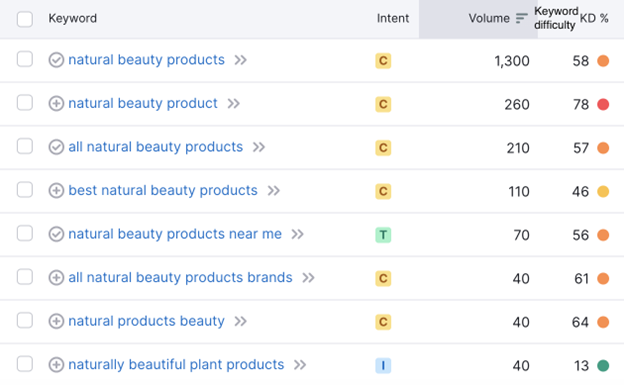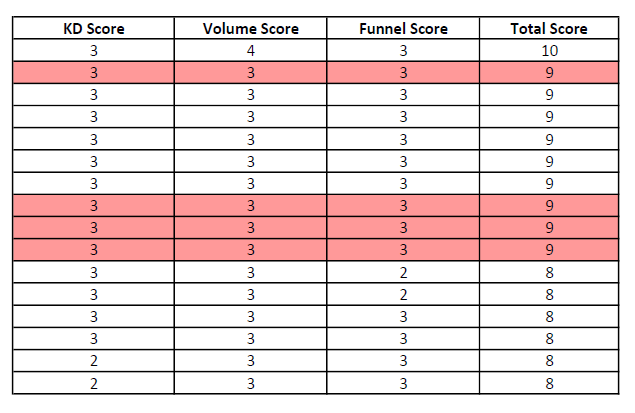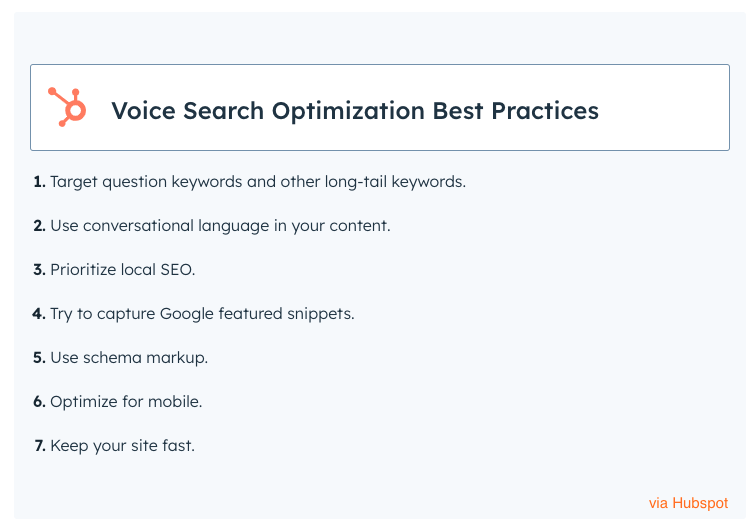
The New Era of On-Page SEO: Navigating AI, GEO & Automation in 2025
Every year, someone proclaims, “SEO is DEAD!” And in 2025, they’re blaming AI for killing it.
But here’s the thing: SEO isn’t dead—it’s evolving. Yes, AI-generated overviews and GEO (Generative Engine Optimization) have changed the game, fewer clicks, more competition. These shifts don’t make SEO obsolete; they make it more important to get your foundational on-page SEO and technical SEO right. Think of SEO like a garden: It needs attention, adaptation, and strategic planting. Let’s dig into what this means for your on-page SEO strategy today.
The New SEO Reality: AI and GEO
Today’s SEO involves more than just keyword targeting. Google’s AI-driven search results now deliver instant summaries (AI-overviews) directly on the search page. While convenient for users, this means fewer clicks to your website, as people may just read overviews and never click an Organic link. To keep up, your strategy needs to go beyond simple keywords and focus on creating deep, meaningful content optimized for traditional SEO and these new generative AI formats—this is GEO.
Optimizing based on the framework below will get you ranked in both. Our long-term clients are ranking for hundreds of AI-Overviews and the First page on Google!
What’s Changed (and What Hasn’t)
Traditional on-page SEO factors—like keyword optimization, structured data, and user experience—still matter deeply. However, optimizing for how AI interprets and presents content is equally crucial.
SEO’s Big Three—Updated for 2025:
On-Page SEO:
- Keywords aligned with personalization and user intent
- Creating content formats easily summarized by AI, like concise FAQs, clearly structured content, and authoritative, trustworthy summaries.
- Optimizing content not just for traditional search engines, but specifically for generative AI results (like Google’s AI-generated answers).
- Google’s E-E-A-T framework (Experience, Expertise, Authoritativeness, Trustworthiness) becomes more critical.
Technical SEO:
- Fast site performance
- Intuitive and easy to follow UX
- Easy crawlability for humans, search engines, and AI crawlers
Off-Page SEO:
- Stronger emphasis on brand mentions, even without direct backlinks, as search engines become more sophisticated in understanding brand authority signals.
- Encouraging natural backlinks through valuable content
- Search engines increasingly weigh social signals, like engagement on LinkedIn, Twitter, or industry forums, as indirect markers of brand authority.
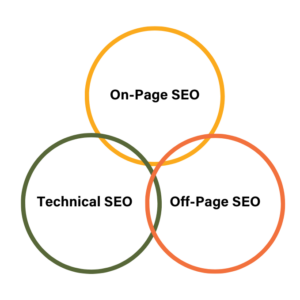
Synchronize Your On-Page SEO Strategy with Your Technical SEO Strategy. Download the Free SEO Performance Toolkit!
Download our Free SEO Performance Toolkit. Perfect for marketing teams, content strategists, and SEO professionals, it outlines the exact process behind our high-performing client strategies—and it’s yours to use for free.
Inside, you’ll find a toolkit that helps you with on-page SEO, plus:
-
Audit your entire site’s content and structure with clarity
-
Spot keyword and content gaps that impact performance
-
Map your site architecture with users and search engines in mind
-
Plan UX improvements that increase engagement and SEO rankings
-
Track technical fixes and strategic actions across your content
This file is ideal for:
-
Marketing leads who want to keep SEO in-house but need a system
-
Content teams planning site updates or restructures
-
SEO freelancers or agencies who want to streamline audits
👉 Download the toolkit and start optimizing with clarity and confidence.
OK, back to the program!
How to Prepare Your On-Page SEO Strategy for AI & GEO
Before diving into keyword research or optimization:
-
Clearly define your audience personas (use our template).
-
Nail down messaging that solves their specific problems. Here’s a messaging template.
-
Map your content topics to what your audience is searching for. We like the mind-mapping technique for topic ideation.
- Understand the audience’s intent to map content to keywords.
-
Know your content’s goals: Business KPIs & Digital Metrics (so you can choose page-level calls to action). Here’s a one-page strategy document
Now, you’re ready to optimize strategically:
Keyword Research
Focus on terms relevant to your offers, and aligned closely with user intent. Prioritize long-tail conversational phrases to match how users (and voice assistants) naturally search.
For this post, we’ll stick with the example of a natural beauty supply store.
This business specializes in ethically sourced beauty products, so it wants to appear prominently when users search terms like “sustainable beauty brands,” “ethical beauty products,” or “small-batch beauty products.”
Targeting long-tail keywords like these helps attract an interested audience to your site, linking from there to a product page, drives the sale forward.
Types of Keywords
Match intent with the user journey stage to craft content for every stage in the funnel (pay attention to the letters in front of the keyword type as they will be the same in SEMRush example below):
- (I) Informational (top of the funnel) – The user wants to find an answer to a specific question
- (N) Navigational (middle of the funnel)- The user wants to find a particular page or site
- (C) Commercial (mid-bottom of the funnel)- The user wants to investigate brands or services
- (T) Transactional (bottom of the funnel)- The user wants to complete an action (conversion)
They also more clearly mirror how people with purchase intent are searching, as shown in this graphic from Moz:

Long-tail keyword-optimized content, internally linked to a head term on a product or service page, defines our hub-and-spoke content strategy—a critical factor in our successful client engagements. However, it’s not a “quick win” strategy.
This On-page SEO content strategy requires consistent creation and optimization over time. It’s a long-term approach, proving to be one of the most effective SEO strategies for ROI.

Why the Hub-and-Spoke Strategy Matters Even More in 2025:
1. Alignment with AI and GEO (Generative Engine Optimization)
Generative AI favors structured, clearly organized information. Hub-and-spoke naturally creates well-structured, semantically related clusters of content, making it easier for AI tools to summarize, extract, and present your content in AI-driven search results.
2. Enhances Semantic SEO and Topic Authority
In 2025, search engines are deeply focused on semantic relevance—understanding not just keywords, but entire concepts. A well-built hub-and-spoke strategy helps your site clearly signal topic authority, showing search engines (and AI tools) that your site covers topics comprehensively.
3. Improved User Experience (UX)
Users prefer easy-to-navigate sites that clearly guide them to related content. This structured content approach helps users quickly find relevant content, improving session duration, engagement, and ultimately conversions.
4. Boosted Internal Linking Structure
Strong internal linking helps distribute page authority and ranking power across your site. Hub-and-spoke architecture inherently creates a solid internal linking network, enhancing crawlability and indexing by both traditional and generative search engines.
5. Facilitates Content Scaling
A hub-and-spoke model allows content teams to scale content production easily. New subtopics (spokes) can continually be added, expanding the central hub’s authority and reach, keeping content consistently fresh and relevant.
6. Supports Voice and Conversational Search
Voice search queries are usually conversational and specific. Detailed spoke pages cater directly to these queries, positioning your brand to appear prominently in voice and AI-driven results.
How to Make Hub-and-Spoke Successful in 2025:
Focus on Intent Mapping:
Align each spoke with specific user intent—informational, navigational, commercial, or transactional—to address different stages of the user’s journey.
Navigational Keywords
Navigational keywords indicate users are searching for a specific site or page they already have in mind. For example, someone familiar with your beauty brand might search directly for “GreenGlow skincare homepage” or “GreenGlow natural face cream” to quickly reach the exact page they’re seeking.
Commercial & Transactional Keywords
Commercial keywords are used by people researching and comparing products or services before purchasing. Examples for your beauty brand include phrases like “best sustainable beauty brands,” “ethical skincare reviews,” or “compare organic facial oils.” These searches show the user is evaluating options, often preparing to buy.
Informational Keywords
Informational or long-tail keywords—phrases consisting of three or more words—are more specific than shorter ‘head terms’ like ‘beauty’ or ‘beauty products.’ Focusing on these longer phrases is beneficial because they have less competition, making ranking easier. They’re also more likely to match the specific intent of users actively looking for exactly what you offer, indicating strong purchase intent.
You must purchase a tool if you plan to do your own keyword research. SEMRush is free for up to 10 searches per day. However, if you have a large website, we recommend subscribing to a beginner plan. We also recommend hiring an SEO Specialist to help you with your keyword strategy before you begin. A specialist like me can give you a solid strategic framework to scale from and upskill you or your team to DIY your SEO for years to come!
Keyword Research with SEMRush
Here’s a workflow in SEMRush for beginning your keyword research.
First, enter your seed keyword into a keyword research tool like Semrush’s Keyword Magic Tool.
A seed keyword is any more significant keyword from your niche used as a stepping stone to finding more keyword ideas.
Select your target location and hit “Search.”

Select your target location from the drop-down menu and hit “Search.”
You want to find keywords that aren’t too competitive but have good search volume.
This is the sweet spot.
Choose keywords that match the user intent stage for the content you plan to create, low to medium competition, and at least 250 searches per month, if possible.
Use sorting in the (KD%) Keyword Difficulty and Volume columns to play around until you see results in the sweet spot range.

As we discussed above, match intent with the user journey stage to craft content for every stage in the funnel.
Competitor keywords
If you’re unsure who your organic search competitors are, head to Google and “Google” your focus keyword for your home page. If you aren’t sure what your focus keyword is, try “Googling” your product or service plus your local area or without the local area modifier to see the national search engine results.
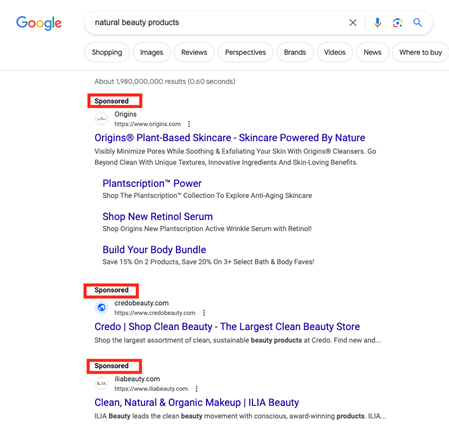
The first three national results above are “Sponsored” results. These are not your organic search competition.
You will see the Organic results list under the Sponsored ads and “People Also Ask” section.
These are your organic search competition for the keyword you “Googled.”
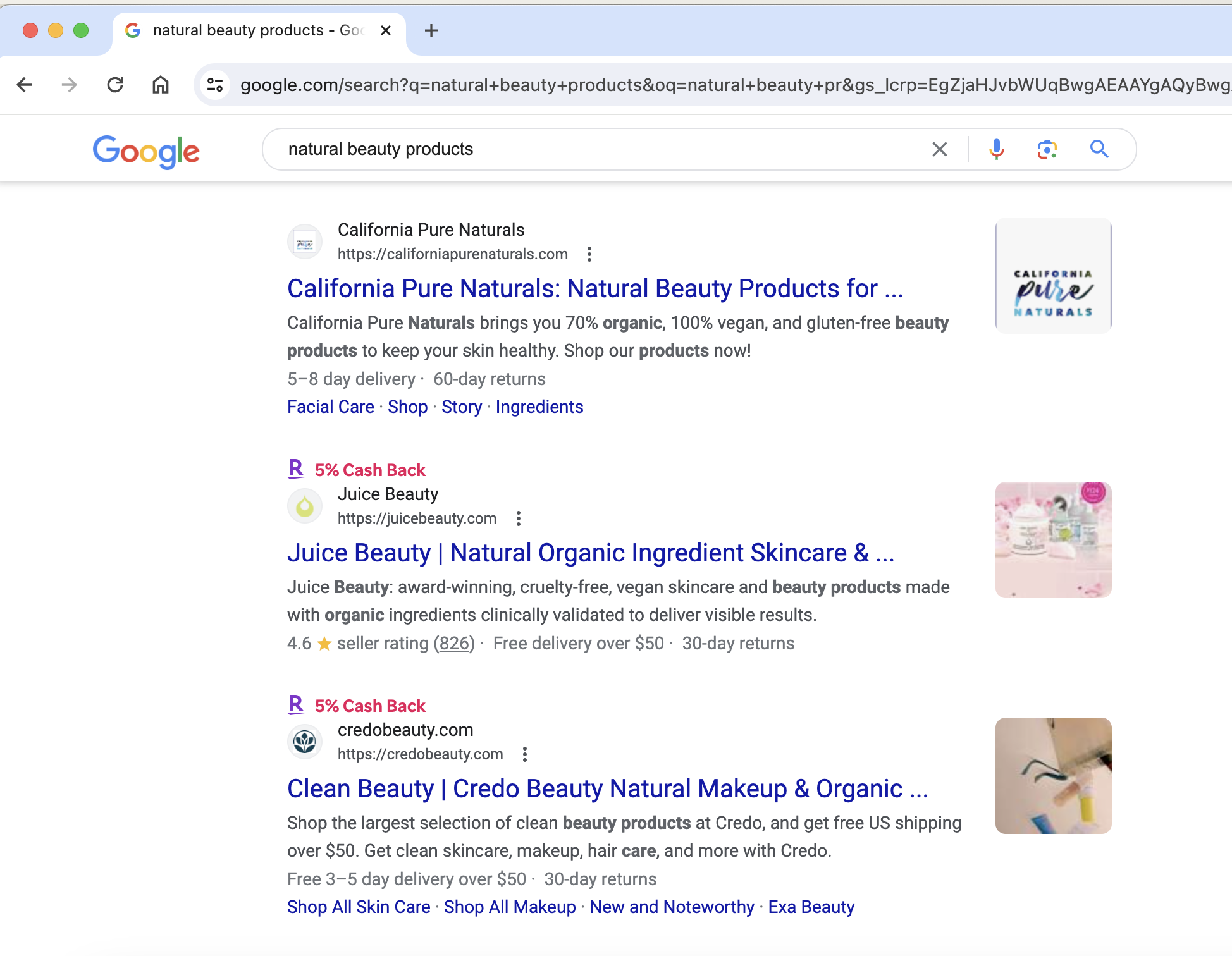
Now, head to SEMRush armed with your top three competitors for your selected keyword. Add your competitor’s URL in the Organic Research tool and hit Search.
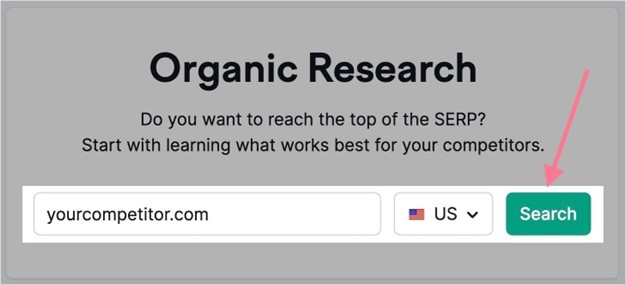
Then, go to the “Positions” tab.
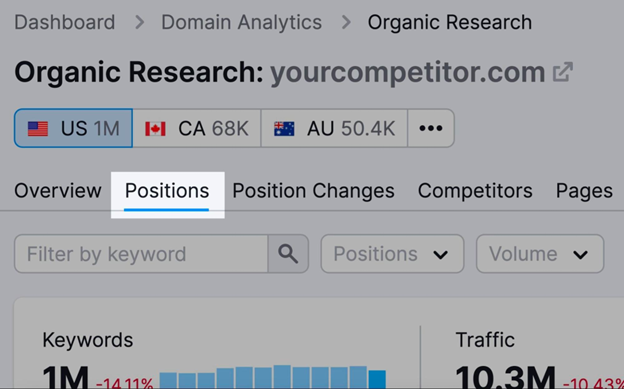
To filter out their brand keywords, go to the right side of your screen and click “Advanced filters” > “Exclude” > “Keyword type” > “Branded.”
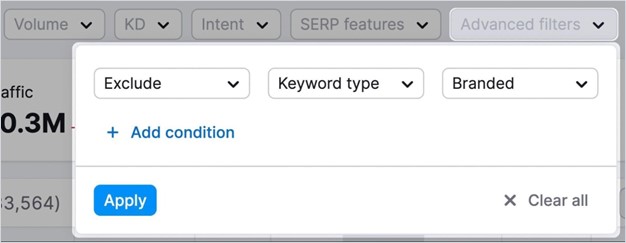
You’ll see a list of your selected competitor’s best keywords, which you could use to optimize your content.
Go through the list. Get some data for your SEO Strategy. Then, repeat the process with another competitor.
Finding Existing Opportunities: Do You Have Any Low-Hanging Fruit Focus Keywords?
You can find keywords you’re already ranking for and ensure they target the correct pages.
How?
Audit existing content using SEMRush.
- Import all existing content URLs into a spreadsheet. You can export the URLs using SEMRush Site Audit tools.
- Enter critical URLs into your site audit tool or Google Search Console to see its best-ranking keywords.
- For each URL, choose a primary keyword from the list (this should be the best-ranking keyword). If there is nothing within positions 4-20 that you’d choose as the focus keyword for the page, then most likely, more keyword research will need to be done from this step. This step will ideally help you identify low-hanging fruit keywords/landing pages if they exist.
Which Keywords to Use
We like creating a keyword matrix in a spreadsheet and working down the list. This approach comes from Maxim Poulsen, a growth expert at @getcontrast.io.
Score keywords using Volume, Difficulty, and funnel stage. BOFU keywords generate leads for quick ROI, while TOFU keywords, like the long-tail ones mentioned earlier, drive traffic and micro conversions, such as social shares and email signups.
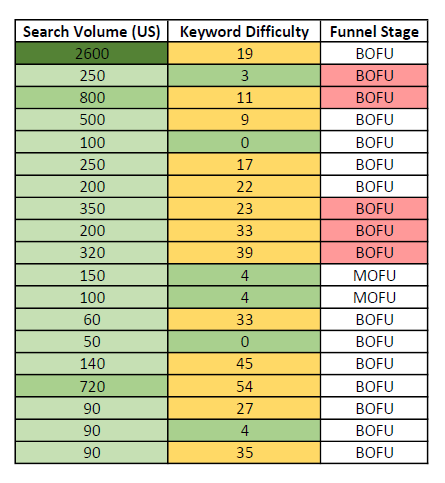
If ROI is a primary goal of your SEO strategy, target BOFU keywords by creating BOFU content first. BOFU content offers an incentive for purchase, often through discounts, free trials, or more services. Examples of content positioned at the bottom of the funnel include product demos, product comparisons, and client testimonials.
How to Use Your Keywords
Don’t make the ‘over-optimization’ mistake so many sites make by trying to rank for multiple keywords at once and stuffing three keywords into a meta title or description.
For the best results, optimize each page for one focus keyword and use that exact phrase in the page title, meta description, headings, and the first 100 words of body content.
Try to use variations of this term throughout the body content, but don’t overdo it. If your content is good enough (think E-E-A-T here), Google will naturally rank it for many keyword variations.
Optimizing Title Tags
The title tag remains the best location for placing your focus keyword in on-page SEO.
As the initial element users encounter in the Search Engine result pages, it provides an opportunity to create a positive first impression.
Use the keyword exactly as it appears in your keyword research tool.
Don’t use a variation.
This is called an “exact match keyword.” I’ve been referring to it as your “focus keyword.”
Below is what a title tag looks like:

Google typically displays a title tag’s first 50–60 characters, so keep yours within that range. The Title tag above was truncated in search results because it is not the optimal length.
In the backend of your site, within the code. A title tag looks like this:
<head><title>Example Title</title></head>
The optimal format for title tags is
Focus Keyword – Descriptor | Brand Name
To keep your titles brief:
- Avoid typing your title in all caps. Uppercase letters take up extra space and could cause your title to get cut off. They can also be harder to read.
- Use symbols to save space (e.g., “&” instead of “and”)
- Since they’re narrower, consider using colons (“:”) or pipes (“|”) as separators rather than hyphens (“-”) or dashes (“–” / “—”)
Make Every Title Tag Unique
Give each of your website’s pages a unique title tag relevant to its target keyword and product/service.
If one of your beauty products is an African Clay Face Mask and you want to attract shoppers looking for that specific product, your title tag for that page would be: [African Clay Mask] – [Descriptor] | [Brand Name]
Front-load the essential words:
❌ Bad: Shop Online For African Clay Mask
✅ Good: African Clay Mask Beauty Products | Brand
Adding Meta Descriptions
Your meta description, visible below the title on search engines and social media, serves as the second impression of your brand.
It’s your initial chance to convey the value your brand provides, address the searcher’s needs, and conclude with a compelling call to action to encourage a click-through to your site.

Stick to one focus keyword for each page’s meta description; keep it under 155 characters.
Pro tip: You can use an online character counter tool for titles and descriptions.
Where you add your metadata will depend on the platform your site is built on (e.g., WordPress, Squarespace, Webflow). Still, every content management system has a meta title and meta description field.
We highly recommend using the Yoast SEO plugin if you are on WordPress, like we are. It will make managing your SEO workflow 1000% easier over time.
You can review your website’s title tags and Meta Descriptions with Semrush’s On-Page SEO Checker.
Import your pages and their target keywords to check whether your Title tags and Descriptions are present, contain the correct number of characters, or if any are missing from your site.
You can work on resolving issues over time by exporting the data to a spreadsheet and scheduling a workflow.
If you work with us, we handle it all. We create and oversee the workflow and provide reporting as part of our ongoing client commitment.
Keyword Optimizing Your On-page Content
Use your exact match keyword within the first few lines of text and at least one header, but use it organically so that it flows within the context and isn’t forced. If you have to force it, reevaluate your language.
You can add a few secondary keywords for longer content, like blog posts or guides.
Believe it or not, Google understands the semantic relevance between terms, so blog posts are a great place to incorporate multiple keywords.
Just be sure you’re writing for humans, not algorithms. Use them in moderation so as not to compromise the quality of your content.
Automate Your On-Page SEO Workflow
Automation can save you valuable time, improve accuracy, and streamline your processes.
Metadata Generation
Quickly draft compelling meta titles and descriptions using ChatGPT.
Example ChatGPT prompt:
- Create a meta title for my page about [insert topic/focus keyword here]. It should be 65 characters or fewer, contain the exact focus keyword, and use the ‘|’ character followed by my brand name at the end.
Content Optimization
AI tools like MarketMuse analyze your entire content inventory, pinpoint high-value topic clusters, and find quick wins based on your existing authority.
Internal Linking
For AI-powered internal linking, LinkStorm stands out as a dedicated tool that analyzes your website, identifies linking opportunities, and suggests relevant links between pages, while Link Whisper is a popular WordPress plugin known for its AI-assisted internal linking suggestions as you write.
Audit Automation
Set Zapier integrations with SEMrush, Google Sheets, and Slack to automate tasks like site-speed checks, broken link notifications, and keyword ranking reports. Part 2 of this series will discuss the Zaps we love for automating audit processes.
Adding Internal & External Links
When you use keywords within your content, you can link them to another page appropriate to that keyword.
Those terms are called anchor text.
Anchor text can provide both search engines and users with relevant contextual information about the content of the link’s destination.

In the above link code example, ‘Tiny dancing horse’ is the anchor text for the link.
Source: moz.com
For example, writing a blog post about beauty regimens and mentioning African Clay Masks is an excellent internal link opportunity.
Use “African clay mask” as the anchor text to link to your African Clay Mask product page.
Or, if you mention the importance of exfoliation but don’t want to go too deep into the science behind it, you can link to a high-search-ranking external article.
Optimizing Headings for Your Keyword
Google says that header tags don’t hold much weight within their algorithm today. However, headers are vital to readability and, thus, the user experience. They create a structure and hierarchy for your information, allowing readers to scan and scroll to find what they need.
Most SEO tools will tell you to add your keyword to your first header. So go ahead and put your focus keyword in your first header tag. In your backend, that’ll look like this:
<header> <h1>Most important heading here</h1> </header>
Optimizing URLs
Your site URLs should include your focus keyword for each page, as indicated by your keyword research.
It should also show the page hierarchy.
For instance:
url.com/category-1/product-1
Or
url.com/blog/blog-1
A page on your website should take at most three clicks to reach from your homepage.
You want to keep your important pages high up in the site hierarchy so bots can efficiently use their crawl budget.
Again, we audit for this when we begin our work with you.
Adding Alt-Text to Your Images
You’ll also want to name any images (photos, graphics, logos, diagrams, etc.) using their relevant keywords before uploading them to your website.
Then, again, add “alt text” in your content management system with the exact match keyword. Consider this extra SEO juice to add to your rankings.
In WordPress, for example, when you add a new image to a page or post, you’re given the option to add alt text when you upload it onto your media library, which looks like this:
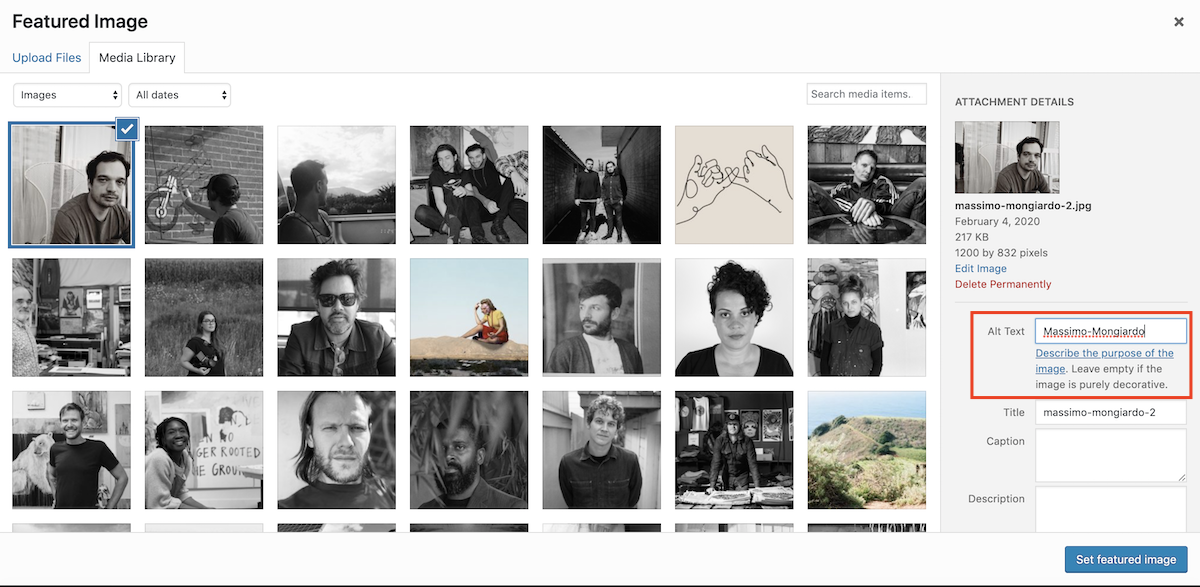
Semantic Search and Natural Language Processing
Rather than solely relying on specific keywords throughout the content, consider the broader context of user intent and the natural language users employ in their search queries.
Nowadays, Google prioritizes content that aligns with user intent. We talked about user intent above, but to understand this more specifically regarding local SEO, let’s take another look at the beauty supply store. Many local search queries contain “near me” in the phrase.
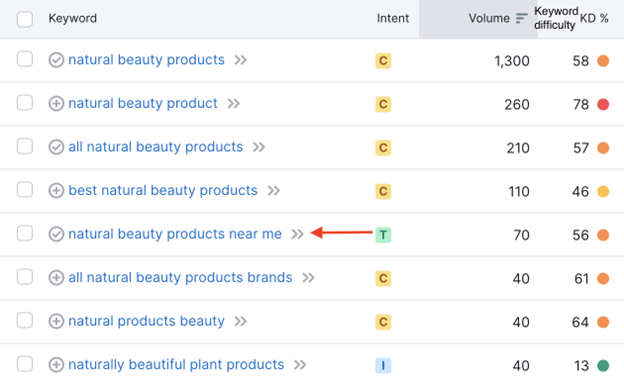
Use semantically related words and phrases, such as the other phrases in this list above, to enhance content relevance. Craft content conversationally, anticipating how users might phrase their queries. You should still aim to choose one focus keyword for every page, but sprinkle in these other naturally related phrases in your body content.
Mobile Optimization
Mobile-friendliness is crucial. Google uses mobile-first indexing, giving preference to mobile-optimized pages in search results.
You will want to bake this part into your web design and development workflow.
Your designer will ensure a responsive website that adapts to different screen sizes and devices. A responsive website maintains a consistent user experience across desktop and mobile.
Mobile-Friendly Testing & Page Speed
We perform tests to check if your website is mobile-friendly. Note that Google sunsetted the mobile usability report in December 2023, and it’s no longer available in Google Search Console, but page speed remains a crucial ranking factor in Google’s algorithm.
The most robust resources for evaluating mobile-friendliness are Lighthouse from Chrome and Google’s Page Speed Insights tool.
If you are not web technical, you will likely need your web developer or designer to help you implement the results of these tools.
User Experience + User Interface (UX/UI):
In the past, UX/UI was not explicitly a part of an on-page SEO strategy.
Things have changed drastically over the last ten years regarding positive user experiences and good page rankings.
When building out navigation and designing menus, ensure your site hierarchy is clear to the user.
We highly recommend working with a web designer or information architect to build your site correctly.
A well-built site will ensure your SEO work doesn’t fall flat.
Top-level categories and sub-categories, and, if relevant, product pages should flow in a logical, well-designed hierarchy with clear call-to-actions on the page.
As part of our SEO Site Audit, we thoroughly analyze your UX/UI to ensure your navigation meets current search standards.
If you want the exact framework we use to evaluate and create a user-friendly and search-friendly UX. Download our Complete SEO Toolkit
Optimizing for AI-Overviews
AI overviews rely heavily on structured, clearly formatted content. Properly implementing schema markup for FAQs, products, and events enhances your chances of being featured.
Structured Data and Schema Markup:
In the past, there was minimal use of structured data.
Results were displayed on a search engine result page as a Title tag and Meta description only.
Now, incorporating schema markup into your HTML enhances the presentation of your page in SERPs, elevating the visibility of rich snippets featured beneath the page title.
Offer a product or service that falls into one of these categories and is willing to do (or pay for) some extra coding. You can significantly enhance the competitiveness of your page results in search.
Structured data is used to provide additional information about the following (not an all-inclusive list):
- Creative work
- Events
- Organizations
- Person
- Place
- Product
- Recipes.
According to Google: “The Food Network has converted 80% of their pages to enable search features and has seen a 35% increase in visits.”
If you want to test structured data on your site, Google’s Structured Data Markup helper is an excellent place to start. If you are not technical, it’s good to have a web developer or designer around to help with this part. As a part of our technical SEO services site audit process, we will evaluate your site for structured data and make recommendations for your three-month SEO strategy game plan.
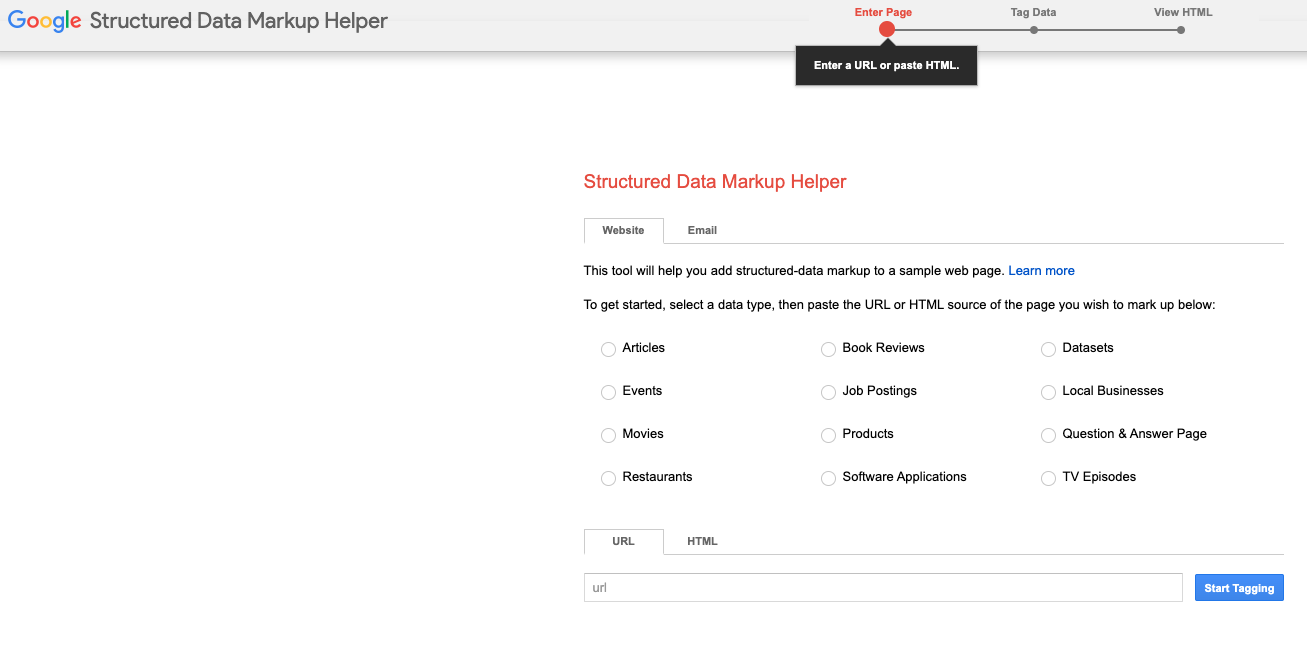
Here’s an example of a rich snippet created with structured data:
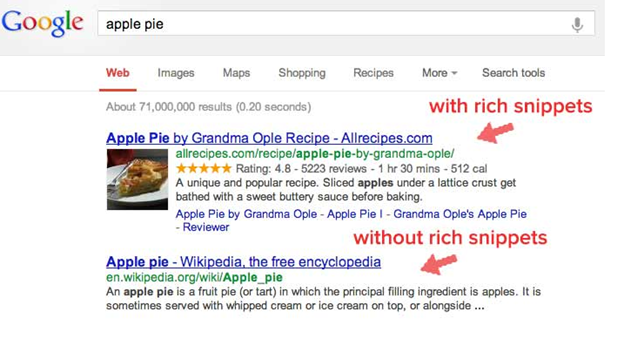
A newer enhanced result is rich cards, which look like this:
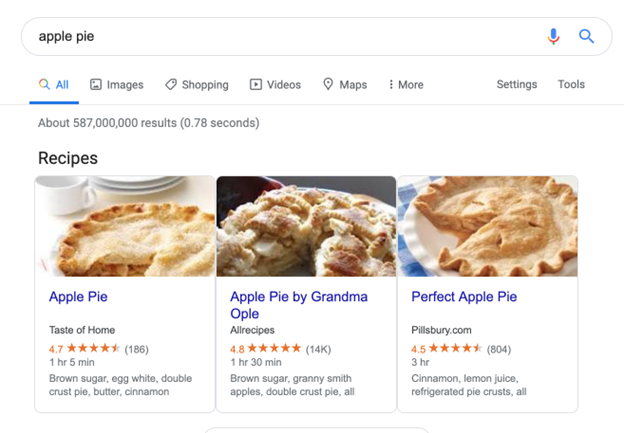
Here’s what rich snippets and rich cards look like on mobile:
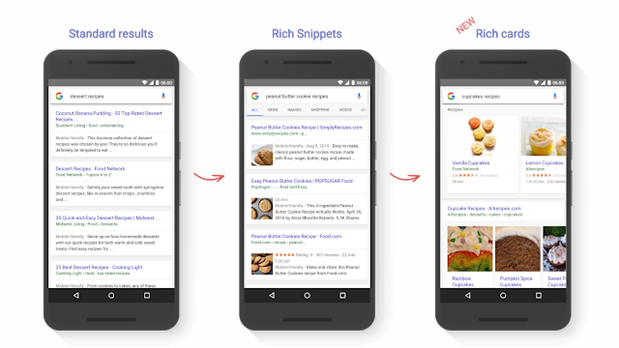
Image source: Google Webmasters.
From a user experience perspective, they provide benefits such as
- Drawing a user’s attention to your relevant result.
- Provide instant information related to their search query.
These aren’t available for all types of sites, so see the complete list of the types of content that Google supports rich snippets for here: Google documentation
Voice Search Optimization:
According to the Hoth: “Over 50% of all internet searches are voice-activated, and that number will continue to increase as more people purchase smart speakers and start using voice features on their mobile devices.”
If you believe Voice Search Optimization will be a growth channel for you in 2024, you will want to optimize for three major platforms: Alexa, Siri, and Google Assistant. For best results, optimize for all three.
How we speak is changing how we search.
For instance, going back to the beauty products example, you might type “natural face mask recipes,” but with voice, you might say, “How do I make a face mask at home?”

These results’ functionality is tied to Google’s Hummingbird update, marking Google’s shift into an “answer engine.”
Now, users receive comprehensive SERP results directly on Google without the need to click through to a website. We see what you did there, Google.
Hummingbird strongly emphasizes semantic search, involving conversational keywords, and understands the implied meaning behind search queries.
Google’s Knowledge Graph presents results in an infobox format, providing a quick snapshot of relevant information.
When present on the search results page (SERP), AI Overviews can significantly reduce organic click-through rates (CTR). Studies indicate a decline of around 70% or even a 60% decrease in average CTR.

RankBrain, an integral part of Google’s core algorithm, can interpret complex queries. Leveraging machine learning, it delivers highly relevant results based on searcher preferences.
For voice search optimization, the focus should shift to conversational keywords tailored to how users express themselves verbally rather than the concise terms entered into a browser.
Consider how you use voice search: you are on the go, in your car, and need directions for “something near you.”
You aren’t looking for extensive text. Instead, you want a featured snippet, a link to a product page, or directions in Google Maps. This search intent emphasizes micro-data and schema markup, which we discussed earlier in this post.
So, if you are a local business looking for nearby users, Voice search might be part of your SEO strategy for 2025.
In Conclusion…
People will always explain the death of this or that, including SEO. They will urge you to invest in the latest trends, like creating Podcasts or Videos for social media.
While dynamic visuals have their place, the written word remains a powerful tool for lead generation, especially for those with smaller budgets and teams.
SEO continues to be a powerhouse component of a successful multi-channel marketing program.
Download our SEO Performance Toolkit. Perfect for marketing teams, content strategists, and SEO professionals, it outlines the exact process behind our high-performing client strategies—and it’s yours to use for free.
Inside, you’ll find a toolkit that helps you:
- Audit your entire site’s content and structure with clarity
- Spot keyword and content gaps that impact performance
- Map your site architecture with users and search engines in mind
- Plan UX improvements that increase engagement and SEO rankings
- Track technical fixes and strategic actions across your content
This file is ideal for:
- Marketing leads who want to keep SEO in-house but need a system
- Content teams planning site updates or restructures
- SEO freelancers or agencies who want to streamline audits
👉 Download the toolkit and start optimizing with clarity and confidence.


